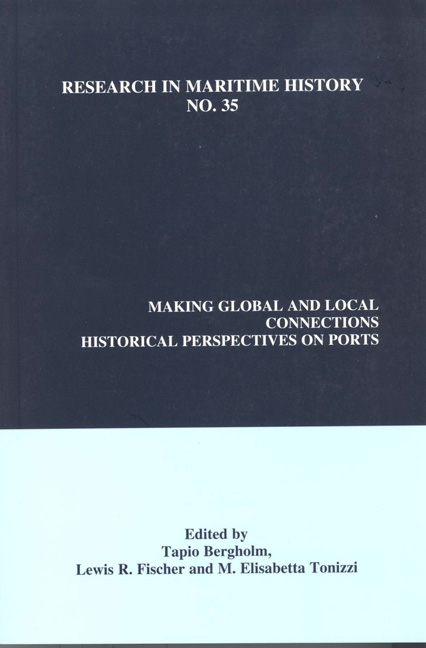Book contents
- Frontmatter
- Contents
- Contributors' Notes
- Contributors
- “Introduction”
- Part I Port Case Studies
- Part II Port Systems
- “The Northwest Portuguese Seaport System in the Early Modern Period”
- “Discourse and the Container Revolution in Finland in the 1960s and 1970s”
- “The Ports of Northern Chile: A Mining History in Long-run Perspective, 1880-2002”
“Discourse and the Container Revolution in Finland in the 1960s and 1970s”
from Part II - Port Systems
- Frontmatter
- Contents
- Contributors' Notes
- Contributors
- “Introduction”
- Part I Port Case Studies
- Part II Port Systems
- “The Northwest Portuguese Seaport System in the Early Modern Period”
- “Discourse and the Container Revolution in Finland in the 1960s and 1970s”
- “The Ports of Northern Chile: A Mining History in Long-run Perspective, 1880-2002”
Summary
The fact that the standardised container has revolutionised transport is somewhat astonshing. Compared to many other technological innovations, the container is a rather simple device. Indeed, its real importance is revealed only when we think of it as comprising an all-embracing “socio-technological system” and pay attention to its more wide-ranging economic, cultural and social impacts. Frank Broeze has noted that the broad meaning of the container was only shaped gradually and that this involved several actors:
Containerization provides an almost perfect model of what may be termed complex innovation. Its first stage was extremely simple in theory and execution. But once the first steps had been taken and the true revolutionary power of the system could be imagined, it swept before it every aspect of liner in a process of rapid transformation at sea, ashore on the wharf and in office, and deep inland.
Marc Levinson aptly notes that “the value of this utilitarian object lies not in what it is, but in how it is used.” The container became both the core and symbol of economic change in transport because it facilitated the development of highly automated, door-to-door transport. In effect, the “box” enabled the creation of a sophisticated system of intermodal transport. Containers radically changed world trade, shipping and ports as they seamlessly linked various modes of transport. As they lowered transport costs, containers began to change not only transportation but also production, trade and consumption, thus providing a strong impetus to economic globalisation.
Despite their great significance, until recently the history of containers has been the subject of surprisingly little research. Nonetheless, a general picture of their introduction and spread is starting to emerge. The latest research, however, makes the container revolution seem much more complex than we previously thought, and the subject has by no means been exhausted. Future studies of the development of container transport in various countries which allow for international comparisons should help to clarify our understanding of this great logistic transition.
From the beginning containerisation has generated an enormous amount of talk, inspired a good deal of writing and led to many seminars and training sessions. In Finland, this was described as “container enthusiasm” or “container fever.”
Information
- Type
- Chapter
- Information
- Making Global and Local ConnectionsHistorical Perspectives on Ports, pp. 137 - 152Publisher: Liverpool University PressPrint publication year: 2007
